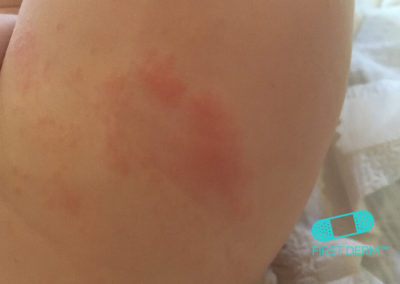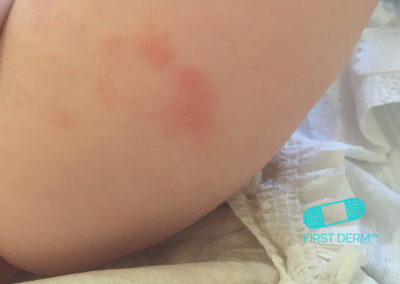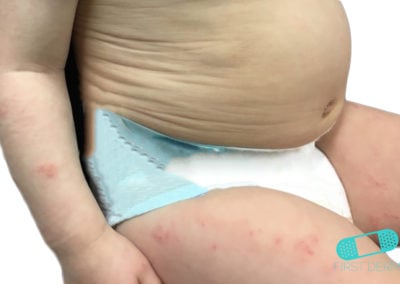Diaper rash (Diaper Dermatitis)
Medically reviewed by The Dermatologists and written by Dr. Alexander Börve
Very Common
- Symptoms: Irritated spots, scales
- Color: Typically bright red
- Location: Warm, moist places (under a diaper)
- Treatment: Lubrication, cream with nystatin, miconazole, clotrimazole, and ketaconazole
Related Blog Posts: When Your Child Says NO to Sunscreen
Diaper rashes are bright red, irritated spots on a baby’s buttocks. They are common in babies (4-15 months old). Babies have very delicate skin, and sometimes despite a parent’s best effort, diaper rash still occurs.
This condition is caused by a fungal infection with Candida, mostly contributed by contact with urine or feces. Some children may also react to substances found in baby wipes. Babies who have more frequent stools/diarrhea or diaper areas that are not kept clean and dry contract diaper rash easily as well.
Try our FREE dermatology search engine and get peace of mind within a second
Symptoms
A diaper rash, as the name suggests, appears in warm, moist places (under a diaper). The bright red rash usually gets bigger, but does not spread beyond the edge of the diaper. However, the irritation can be complicated by a yeast infection.
It can develop glaring red scales on the scrotum and penis in baby boys, and on the labia and vagina in baby girls.
The rash may turn into pimples, blisters, ulcers, large bumps, or sores filled with pus. Sometimes, smaller red patches (satellite lesions) grow into other patches.
Try our FREE dermatology search engine and get peace of mind within a second
What can I do?
A way of preventing diaper rash is to change the diaper more often and air-out the baby’s bottom thoroughly. This reduces moisture on the skin that can inflame a rash.
You can do so by putting the diaper on loosely. This prevents it from rubbing the skin.
Let the baby go around without a diaper as much as possible – preferably for several hours. But keep in mind to prevent older infants from scratching the affected areas once the diaper is removed.
Change diapers as soon as possible after the baby urinates or passes stool. Then, use water and a soft cloth or cotton ball to gently clean the affected area with every diaper change. Use a squirt bottle of water if the baby’s skin is sensitive. Pat dry or air-dry the area.
Lubricate the rash with a protective cream or zinc oxide diaper cream. If your baby has severe diaper rash, layer it on like you are frosting a cake.
Consider using absorbent diapers instead to keep the skin dry. They can reduce the risk of infection. If possible, stop antibiotics treatment for the baby or the mother who is breastfeeding.
To protect the baby’s and your own skin, always wash your hands before and after changing a diaper.
Try our FREE dermatology search engine and get peace of mind within a second
Should I seek medical care?
Contact a healthcare provider, if the rash gets worse in 2-3 days or spreads to the abdomen, back, arms or face. The same applies if you notice a skin infection has developed. This means seeing pimples, blisters, ulcers, large bumps, or sores filled with pus. Another sign of a skin infection is if the baby has fever, is in pain or is hard to console.
Treatment
Try different types of creams and ointments to see which one works out best for the child.
Nystatin, miconazole, clotrimazole, and ketaconazole are commonly used medicines for yeast diaper rashes.
For severe rashes, a steroid ointment, such as 1% hydrocortisone, may be applied. You can buy these without a prescription. But ask your provider first if these medicines will help.
Try our FREE dermatology search engine and get peace of mind within a second
Source:
U.S. National Library of Medicine. Diaper rash. Available at: https://www.nlm.nih.gov/medlineplus/ency/article/000964.htm
American Academy of Dermatology. Diaper rash: How to treat. Available at: https://www.aad.org/public/diseases/rashes/diaper-rash-how-to-treat
Ask a Dermatologist Now
Anonymous, fast and secure!

The Specialist doctor from the University Hospital in Gothenburg, alumnus UC Berkeley. My doctoral dissertation is about Digital Health and I have published 5 scientific articles in teledermatology and artificial intelligence and others.




